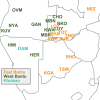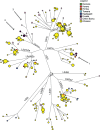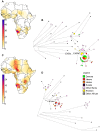Migration and interaction in a contact zone: mtDNA variation among Bantu-speakers in Southern Africa
- PMID: 24901532
- PMCID: PMC4047067
- DOI: 10.1371/journal.pone.0099117
Migration and interaction in a contact zone: mtDNA variation among Bantu-speakers in Southern Africa
Abstract
Bantu speech communities expanded over large parts of sub-Saharan Africa within the last 4000-5000 years, reaching different parts of southern Africa 1200-2000 years ago. The Bantu languages subdivide in several major branches, with languages belonging to the Eastern and Western Bantu branches spreading over large parts of Central, Eastern, and Southern Africa. There is still debate whether this linguistic divide is correlated with a genetic distinction between Eastern and Western Bantu speakers. During their expansion, Bantu speakers would have come into contact with diverse local populations, such as the Khoisan hunter-gatherers and pastoralists of southern Africa, with whom they may have intermarried. In this study, we analyze complete mtDNA genome sequences from over 900 Bantu-speaking individuals from Angola, Zambia, Namibia, and Botswana to investigate the demographic processes at play during the last stages of the Bantu expansion. Our results show that most of these Bantu-speaking populations are genetically very homogenous, with no genetic division between speakers of Eastern and Western Bantu languages. Most of the mtDNA diversity in our dataset is due to different degrees of admixture with autochthonous populations. Only the pastoralist Himba and Herero stand out due to high frequencies of particular L3f and L3d lineages; the latter are also found in the neighboring Damara, who speak a Khoisan language and were foragers and small-stock herders. In contrast, the close cultural and linguistic relatives of the Herero and Himba, the Kuvale, are genetically similar to other Bantu-speakers. Nevertheless, as demonstrated by resampling tests, the genetic divergence of Herero, Himba, and Kuvale is compatible with a common shared ancestry with high levels of drift, while the similarity of the Herero, Himba, and Damara probably reflects admixture, as also suggested by linguistic analyses.
Conflict of interest statement
Figures




References
-
- Phillipson DW (2005) African archaeology. Cambridge: Cambridge University Press.
-
- Bostoen K (2007) Pots, words and the Bantu problem: On lexical reconstruction and early African history. J Afr Hist 48.
-
- Blench R (2006) Archaeology, Language, and the African Past. Rowman Altamira.
-
- Nurse D, Philippson G (2003) Towards a historical classification of the Bantu languages. In: Nurse D, Philippson G, editors. The Bantu Languages. London/New York, Routledge. pp. 164–181.
-
- Vansina J (1995) New Linguistic Evidence and “The Bantu Expansion.”. J Afr Hist 36: 173–195 10.1017/S0021853700034101 - DOI
Publication types
MeSH terms
Substances
LinkOut - more resources
Full Text Sources
Other Literature Sources

